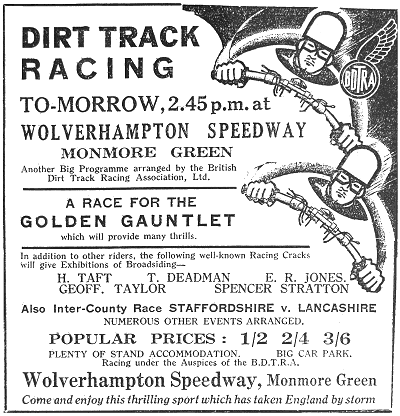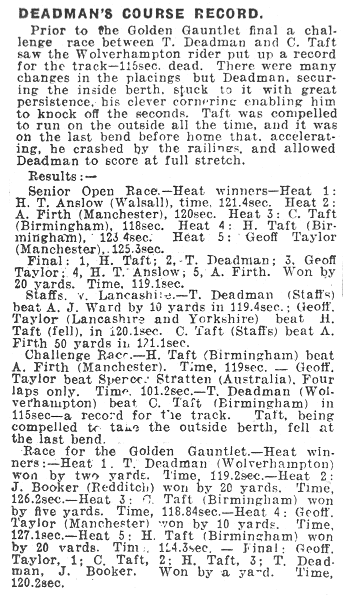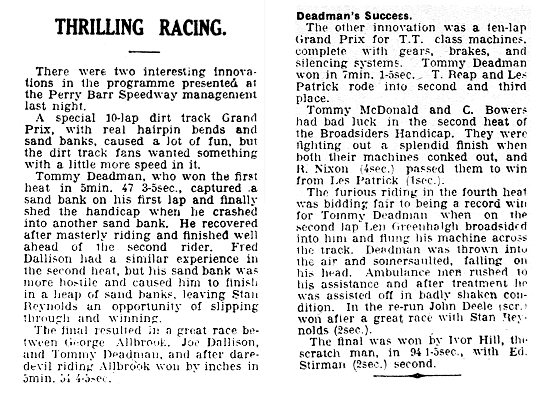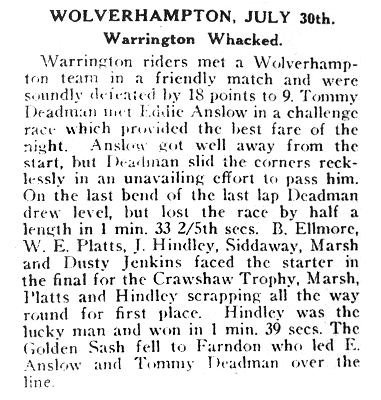|
Tommy was soon fully fit again and
competed in the meeting held on Saturday 25th
August, the first event organised at Wolverhampton by
the British Dirt Track Racing Association Limited. The
meeting would be another eventful one for Tommy because
after beating E. R. Jones in the match race, he took a
fall in the 500c.c.final and received bruises to his
shoulder and right leg.
Tommy’s success continued and
during the next meeting on 1st September he
claimed the track record with a time of 75 seconds.
Things didn’t all go his way. On 22nd
September after winning the 500c.c. final, another
competitor Bunny Wilcox claimed that Tommy had cut him
up. As a result the race was re-run and this time Harry
Taft finished in first place.
Tommy had another accident on 17th
July 1929 when the strap of his goggles broke in two as
he pulled them over his helmet. As a result he had to
ride without them on an extremely dry and dusty track.
During the race he was almost blinded by the dust and
came off after striking the grass verge.
On 20th August, 1929 the
track was illuminated for the first time, and Tommy won
the Monmore All-Star Handicap. On 11th June,
1930 the Wolverhampton team rode at an away event for
the first time and travelled to Exeter for a series of
inter-track races. Tommy took part and beat Dilly
Gittens for the privilege of representing Wolverhampton
in the final. Unfortunately he was beaten by Exeter’s
Reg Beer.

A newspaper cutting, date unknown.
Courtesy of June Hussey.

A newspaper cutting, date unknown.
Courtesy of June Hussey.
Tommy captained Wolverhampton and
Leicester, and rode in the first race at Wembley on the
launch of the new track. He became one of the first
riders to use a leg-forward style and successfully rode
at many of the other new speedway tracks including
Hanley, Nottingham, and Perry Bar.

A newspaper cutting, date unknown.
Courtesy of June Hussey.
As speedway became more popular,
Sunbeam decided to produce a speedway machine, a version
of the Model 90 with a lowered frame and small petrol
tank. Unfortunately the machine was not a great success
because it used standard T.T. type forks which made the
machine almost unmanageable on the tight curves of the
track. Tommy tried the new machine, but even he couldn’t
make it perform. It took a lot of persuasion by him and
the few riders who used the machines, to make Sunbeam
change the design.

A newspaper cutting, year unknown.
Courtesy of June Hussey.
Tommy had a relatively short
speedway career. He greatly enjoyed
speedway and treated it as a hobby. He had many other
interests and didn’t want to devote all of his spare
time to the sport. His last appearance on the track at
Monmore Green was in August 1978 at a reunion of former
riders, which formed part of the celebration of the
track's jubilee. The veterans included Cyril Francis,
Derek Timms, and Ernie Baker. They were each presented
with a special jubilee memento.

Tommy
(3rd from left) at the jubilee celebration
at Monmore Green. Courtesy of June Hussey. |
|